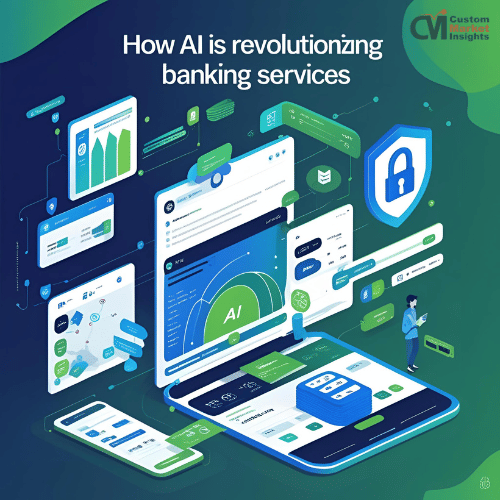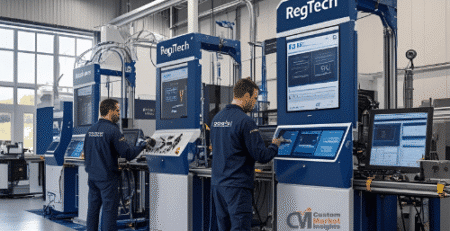Many things are changing in the global banking business, such as new technologies, changing customer needs, and competition from fintech companies. Artificial intelligence (AI) is driving this change. AI is changing traditional banking tasks like customer service, fraud detection, and credit underwriting. CMI’s most recent report says that putting AI into banking is more than just an upgrade to technology. It changes how banks treat their consumers.
AI in Banking: A Big Step Forward in Technology
Artificial intelligence is changing the way banks work by making it possible to automate tasks, tailor services to individual customers, and make smart decisions. Over time, banks and other financial organizations are becoming more flexible and focused on their customers. For example, AI chatbots can answer millions of client questions right away, and predictive analytics can help them make better decisions about loans. AI systems can look at huge amounts of data at speeds that have never been seen before. As a result, artificial intelligence lets banks and other financial institutions guess what their consumers need and give them personalized solutions through mobile apps, online portals, and even in-person meetings.
The 2025 Financial Services Analysis from CMI says that banks that invest in AI technologies may be able to cut their operating costs by up to 25% over the next five years. A Senior Analyst at CMI says that AI is no longer just a beneficial idea; it’s a strategic necessity for banks and other financial institutions that want to stay ahead of the competition in the digital age. AI helps banks and other financial institutions focus on providing valuable services by automating boring processes and lowering the number of mistakes they make.
AI is Making the Banking Industry Better for Customers:
AI is a significant component of making modern banking easier to use and more responsive, which is the most important thing for customers. AI-powered recommendation engines enable banks to deliver each consumer personalized financial advice, product options, and guidance on how to budget. Erica by Bank of America and Eva by HDFC Bank are two examples of virtual assistants that use conversational AI to aid customers, process transactions, and answer questions 24/7.
AI also makes smart onboarding systems possible. These systems let customers open accounts, ask for loans, or prove who they are with little or no support from people. AI makes natural language processing (NLP) better by helping banks understand how consumers feel and respond in the right way. According to CMI’s research, 70% of customers are more likely to trust banks that employ AI to make their services better. The evidence shows that these kinds of technologies are growing more popular and in demand.
Using AI and Machine Learning to Stop Financial Crime:
Cybercrime and fraud are more likely to happen when there are more digital transactions. In the battle against fraud and other financial crimes in banking, AI is becoming more and more crucial. Machine learning models are significantly better at spotting unexpected trends and identifying transactions that look suspicious in real time than systems that use rules. AI helps banks check for risk more thoroughly and make sure they obey standards like AML (Anti-Money Laundering) and KYC (Know Your Customer).
HSBC revealed not long ago that it is deploying AI-based techniques to stop money laundering and false account activity. The system uses AI to look at billions of transactions and find patterns of behavior that could be dangerous. This proactive strategy speeds up reaction times by a lot and saves both banks and customers money.
Using AI to Check Credit Risk: A Method Based on Information
AI is having a major impact on two extremely critical areas: credit scores and loan approvals. Most of the time, traditional methods of verifying credit employ tiny datasets, which might lead to prejudice or exclusion. AI, on the other hand, looks at additional credit data, such as how much you spend, how often you use social media, how you pay your bills, and other things, to develop a better risk profile.
Fintech startups like Upstart and Zest AI have already proved that AI-driven lending works by cutting the number of people who don’t pay back their loans and making credit more available to people who don’t have it. Now, ordinary banks are doing the same thing and putting AI models into their systems for managing credit risk. CMI’s market analysis shows that by 2030, more than 60% of loan origination processes around the world will include some type of AI-based scoring or validation.
Problems with ethics and rules:
AI is good for banking in many ways, but it also makes people worry about data security, accountability, and transparency. Regulators all around the world are working on guidelines to make sure that AI is used legally in the financial services business. The European Union’s AI Act and the Reserve Bank of India’s laws on digital lending are two examples of how to keep an eye on how AI is utilized in banking.
A CMI analyst added, “Banks need to find a balance between being responsible and coming up with new ideas.” “Without strong ethical frameworks and data governance, the promise of AI could quickly become a problem.” As more banks use AI, it becomes more and more vital to make AI judgments explicit, have algorithms that can be explained, and have people look over AI.
The Future and Market Momentum:
The banking AI industry is going to grow extremely quickly. According to CMI’s 2024 Banking Technology Forecast, the worldwide AI in the banking industry would grow at a CAGR of more than 22% over the forecast period. More digital transactions, changing client expectations, and the need for real-time analytics will all help this expansion. Banks are working with big IT corporations and AI startups to build new, cutting-edge solutions.
Recent occurrences show that things are moving even faster. JPMorgan Chase has spent money on building its own AI model to give investment recommendations. ICICI Bank in India has also launched iLens, a digital loan platform that uses AI. Banks are becoming more and more digital-first, but AI will still be a big part of their plans for new innovations.
Finally: An AI Method That Puts People First
AI can make many banking services faster and easier to use, but the fundamental purpose is to help people, not to replace them. To build trust and long-term relationships, we need to use a human-centered approach that blends the speed and efficiency of AI with people’s capacity to understand and judge. In the future, AI will make banking smooth, smart, and tailored to each person. The next wave of banking innovation will come from people that invest wisely in AI while keeping their clients’ demands and ethics in mind.
Connect with our Experts


